introduction
You find a pretty and interesting postcard in a secondhand
bookshop, maybe in France, or on e-bay. But the correspondent
did not date their message and the postmark franking on
the stamp is smudged. Can you discover how old the card
is?
To help make some sense of being able to date old postcards,
first we give a short general history of postcards. This
is be followed by more detailed listings for some countries
- Great Britain, the United States of America and France.
a
general history of postcards
1869, 1 October: the first postcard, a pre-printed correspondence
card, was sent through the public postal service in Austria.
The card had the address on one side and a message on
the other, but no picture. Before this, there were advertising
cards that were often hand-delivered.
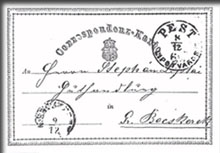
One of the first postcards, sent
in Austria in 1869
As people caught on to the usefulness of this cheap and
fast method of sending messages, the poor man’s
telegram - remember the telephone did not yet exist -
national postal services authorised the sending of postcards
through their postal systems.
- Date when postcards were first mailed:
- 1870 - Switzerland, Britain
1871 - Belgium
1872 - Russia, France
1873 - U.S.A. (government-issued pre-stamped), Romania,
Japan
1874 - Germany
Postcards started to be sent internationally in 1875,
after the first meeting of the General Postal Union in
Berne.
The main changes in the appearance of postcards were
- the undivided back: the address
was on one side and the message, or later, the picture
and message, on the other
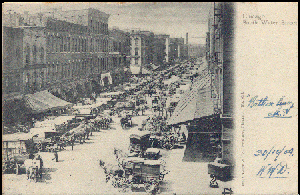 |
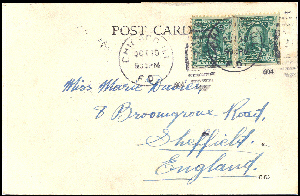 |
| Postcard from 1904
(Chicago) with an undivided back and a small space
available messages on the card front. |
- the introduction of images on one side
started in the 1890s when small pictures encroached
on the writing area of the message side.
1889:
the publication of a postcard of the newly opened Eiffel
Tower as part of the Paris Exposition Universelle.
With over 300,000 copies were sold to visitors, this
postcard helped popularise the illustrated souvenir
postcard and secure the postcard format
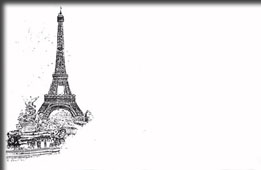
1889 postcard of the Eiffel
Tower
Because only the address was allowed on the back of
the postcard, messages were written on the same side
as the picture. Below is an example, written anywhere
and everywhere.
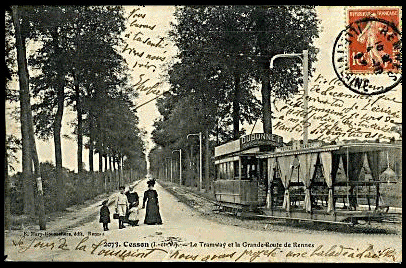
Cesson - Grande Route de Rennes
and tramway. Postmarked 1910
- 1894: first picture postcards produced in the UK
- the divided back permitted the message
be on the same side as the address.
Introduced - 1902: U. K.; 1904: France; 1905: Germany;
U.S.A. - 1907.
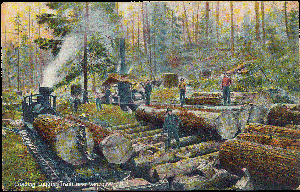 |
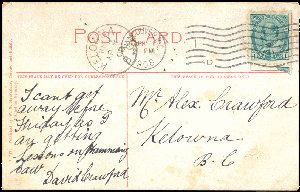 |
| Postcard with an
unusual divided back showing logging in Vancouver,
Canada. Postmarked 1908. Printed in Germany. |
Thus, the other side could be to be used entirely
for the picture. Previously, messages had been crammed
onto the same side as any image.
- linen: From 1930, this was a U.S. innovation,
appearing during a period when linen type paper stock was used,
together with synthetic organic printing inks, with saturated
pigments based on coal tars. This allowed brighter colour printing
that was also aided by the woven fabric texture. The linen texture
enlivened the image by reflecting
the light in multiple directions.
At first,
these postcards included a white border:
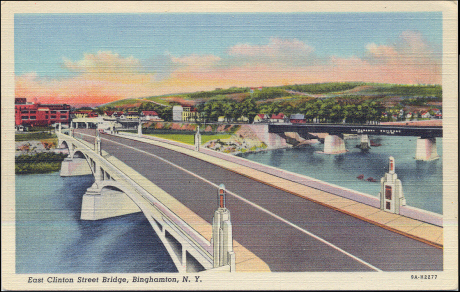
Linen postcard with a white border. Date
unknown. Note horizontal grain.
But this gradually
disappeared as printing extended to the edges of the card: 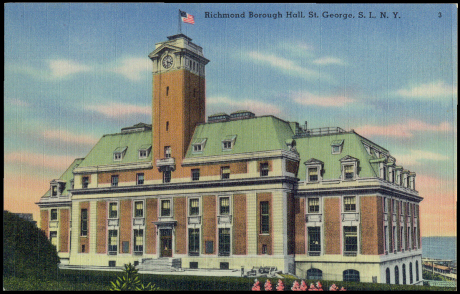
Linen postcard without a border. Date
unknown. Note vertical grain.
Most
linen postcard production stopped in 1939 with the start of World
War Two, although some printers continued with this fabric-based
printing stock until the early 1950s. - photochrome:
Introduced in 1939, the modern chrome postcard, with richly coloured
photographic images and no border on one side. Most linen and
black and white postcard publishers either shut down or converted
to producing Chrome postcards.
other
means of dating postcards It must be remembered
that many years, even decades may pass between the taking of a
photograph, when it was published on a postcard, and when the
postcard was posted. Further, from time to time, reproductions
of old pictures or photographs are repeated some decades later.
Another possibility for finding an old postcard with a relatively
modern postmark date is someone had taken the whim to stamp and
post a vintage postcard.
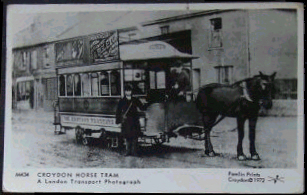 | 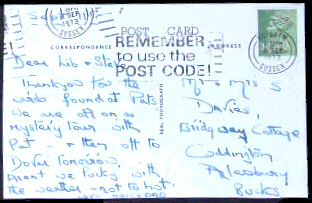 |
| Modern
‘Pamlin’ reproduction of postcard probably originally
produced in the very early 20th century, postmarked 1973 |
Other clues can help date a postcard: - The
postmark
However, this will give the date of the postcard’s
expedition, rather than its production date. - Photographic
and printing techniques, which can be ascribed to different periods
Real photo postcards [RPPCs]
In 1903, Kodak started making the No. 3A Folding Pocket Kodak
camera. This lightweight simple camera was preloaded with a 100
exposure film. When all used, the camera and film were returned
for processing either as sepia prints or as postcards. The resulting
Real Photo postcards were photographs reproduced by making photographic
prints onto paper the size and weight of a postcard, printed with
a postcard back. 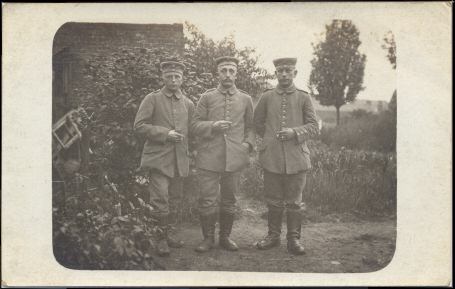
German soldiers on a Real Photo postcard.
Pre-1914
- Different paper types and qualities
were used at different periods. The paper’s colour - for
instance, whether it is green, beige, blue or pink - also can
indicate its period.
- The publisher, also called the editor.
Each were productive over different time periods.
- The
printed legends on the back of the card. When private produced
postcards were first permitted, they were called Private Mailing
Cards. Later, they were called Post Cards. There were also other
legends such as Souvenir Cards. Legal legends, printer’s
details and other printing also evolved. Here follows a selection
in approximate date order:

Detail from a French postcard,
between 1901 and 1907

Detail from a Canadian postcard postdated
1914

Detail from a Canadian postcard,
probably from about 1910
- The card’s design
or style:
Each period has a characteristic look, with Art
Noveau cards from the 1900s, Art Deco from the 1920s and heavily
coloured photos appearing typically from 1920 - 1930. 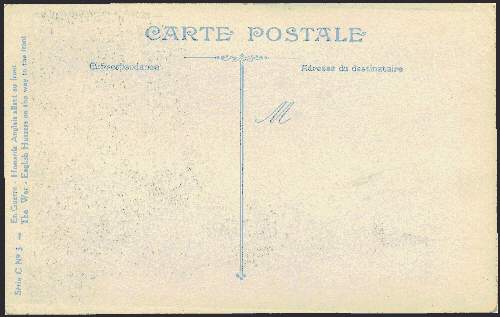
back of an Art Nouveau postcard
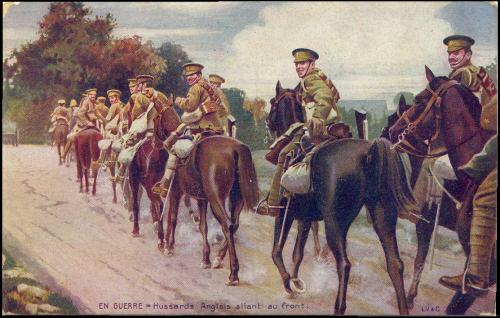
front of the same Art Nouveau
postcard. (The caption on the card’s back reads:“In
war - English Hussars on the way to the front”.)
- Artist’s signature: an artist worked at a particular
period, so their signature can help date the postcard
- Buildings,
vehicles, clothing and more:
these can help date a postcard
- - be aware that motorcars were not widespread
before the early 1900s, before that vehicles were horse (or mule)-drawn.
- Both men and women’s fashions changed, as did uniforms.
-
Certain buildings were built at certain dates. For unknown buildings,
again certain styles, such as Art Deco, only appeared after a
certain date.
- Street names can help too - Some street
names only appeared after a certain event. For instance in France,
streets (avenues, boulevards, places etc) named after US President
Wilson can only appear after 1913 when Woodrow Wilson was first
elected president.
- Memorials shown in postcards can also
help in dating. Thus a First World War memorial can only be illustrated
on a card from after WW1. Every French commune is required to
have such a memorial, well-cared for and decorated with flowers
every 8th May and 11th November, usually with an accompanying
ceremony.
- The handwriting, and even the wording
of the message may give stylistic, cultural or historical clues
about when that message was written.
- Black and white or
coloured images:
It is believed that the first multi-coloured
card, the Heligoland card, was issued in 1889. The divided back
(1902 - U. K., 1907 - U.S.A.) meant that one side could be used
solely for the image. Before coloured images were printed, black
and white postcards were hand-coloured
by women working piecemeal. They would lick the tip of their brush
as they worked. However, many of the paints were lead-based, and
after several deaths, hand-colouring cards was stopped. Black
and white postcards were then coloured by adding printed colours
to the card. With colour photography, this colouring method became
almost non-existent. |
france
new! Cathedrale Saint-Gatien at Tours 
 updated: Romanesque churches and cathedrals in south-west France updated: Romanesque churches and cathedrals in south-west France
the perpendicular or English style of cathedral 
the fire at the cathedral of Notre-Dame de Paris

cathedral giants - Amiens and Beauvais
Stone tracery in church and
cathedral construction 
stone in church and cathedral construction stained glass and cathedrals in Normandy  
fortified churches, mostly in Les Landes
cathedral labyrinths and mazes in France
using metal in gothic cathedral construction
Germans in France
cathedral destruction during the French revolution, subsidiary page to Germans in France

on first arriving in France - driving
France is not England
paying at the péage (toll station)

Transbordeur bridges in France and the world 2: focus on Portugalete, Chicago,
Rochefort-Martrou
Gustave Eiffel’s first work: the Eiffel passerelle, Bordeaux
a fifth bridge coming to Bordeaux: pont Chaban-Delmas, a new vertical lift bridge
France’s western isles: Ile de Ré
France’s western iles: Ile d’Oleron
Ile de France, Paris: in the context of Abelard and of French cathedrals
short biography of Pierre (Peter) Abelard
Marianne - a French national symbol, with French definitive stamps
la Belle Epoque
Grand Palais, Paris


Pic du Midi - observing stars clearly, A64
Carcassonne, A61: world heritage fortified city
Futuroscope
Vulcania
Space City, Toulouse
the French umbrella & Aurillac
50 years old:
Citroën DS
the Citroën 2CV:
a French motoring icon
the forest as seen by Francois Mauriac, and today
Les Landes, places and playtime
roundabout art of Les Landes
Hermès scarves

bastide towns
mardi gras! carnival in Basque country
country life in France: the poultry fair
what a hair cut! m & french pop/rock

Le Tour de France: cycling tactics 



|
postcards
in the united kingdomThe “paid-for by sender”
postal system was developed by Rowland Hill. A standardised postage
was paid for by the sender, who purchased a stamp to attach to
the letter, rather than the receiver. The first stamp was the
Penny Black, issued on 6 May 1840. The stamp showed a side portrait
of Queen Victoria at age 15. (The first French postage stamp was
issued on 1
January 1849.) - 1870:
The first UK postcards introduced by the Post Office. They were
plain cards and had a pre-printed stamp. The sender wrote the
address on one side of the card and a brief message on the other.
There was no picture.
- 1894,
1 September: the Post Office allowed postcards
published by other than the government to be posted. A halfpenny
adhesive stamp was added to these cards before posting. Not having
to print a stamp onto the card freed the postcard publishers to
use any printing method, this freedom allowing publishers to produce
photographic images. By selling postcards without a printed stamp,
the price was reduced.
- 1895:
postcard size adopted to be 4.75 ins x 3.5 ins/12 cm x 8.9 cm,
and known as Court Cards. The address was written on one side.
On the reverse was a small picture with sufficient space for a
written message.
- 1899:
the UK adopted the internationally accepted standard postcard
size of 4.75ins x 3.5 ins. The address and stamp were on one side,
while the other side held an image and any written image. Because
the image often occupied a good deal of the space, the message
would be crammed in around the edges of the photograph side of
the postcard.
- 1902: the UK Post
Office decreed that the image should be on one side
(the ‘front’ - recto), while the ‘back’
(verso) was divided with the message put on the left,
and the address and stamp put on the right. Britain
was the first country to adopt this format.
- Manufacturers soon produced postcards with a line on
the back to indicate the division between message and address.
- 1926:
Allowed postcard sizes were specified:
- Minimum size: 4
ins x 2.75 ins / 10 cm x 7 cm
- Maximum size: 5.875 ins
x 4.125 ins / 15 cm x 10.5 cm
- There were some larger (giant)
postcards made during the early twentieth century, they became
more widespread later in the century.
postcards
in the u.s.a. - 1873:
Pre-stamped postal cards issued by the American Postal Service.
- 1898, 19 May: private
publishers and printers allowed to produce postcards. Senders
had to attach a 1¢ stamp. Manufacturers required to print
the words “Private Mailing
Card” on the back of the card. Changing design features
can help approximate dating of these cards
- Messages were
not allowed on the address side (the back) of the Private Mailing
Card, so some small blank area was often left on the front/picture
side for writing short messages.
- Further information
printed on the back of the card included “Authorized by
Act of Congress of May 19, 1898”, “This side is exclusively
for the Address”and often “Postal Card - Carte Postale”,
indicating the card might be sent abroad.
- 1901:
The labeling on the back of the postcard changed from “Private
Mailing Card” to “Post Card”. Messages were
still not allowed on the back with the message. The back was undivided
by a line.
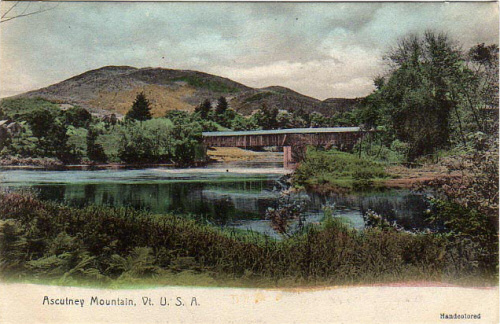 |
| Ascutney covered bridge
on a hand-coloured postcard, 1906 |
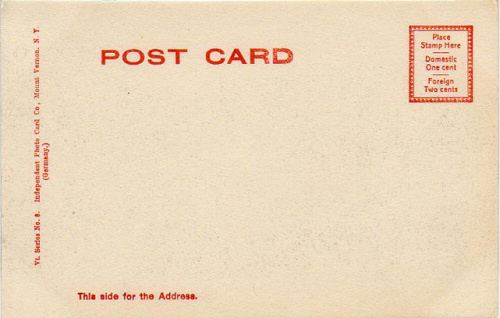 |
| Reverse of postcard
- postage: 1 cents domestic, 2 cents foreign |
- 1907, 1 March:
The back was divided by a vertical line and messages were allowed
in the smaller left area, while the address was put on the right.
The blank area on the front for messages was no longer included.
- 1915:
To save ink, US printers left a white border around the picture
on the front of the postcard. The back of the card was divided
more evenly, making the message area bigger. More description
of the photograph was included on the postcard back.
- 1930
- 1944: Because of improved printing processes, brightly
coloured images were printed on postcards made with a high rag
content. The resulting postcards looked as if they were printed
on linen cloth. The white border often remained, but there were
also Linen Period postcards with no white border.
- 1939:
The Union Oil Company started carrying photochrome-style postcards
in their western service stations. The postcard images are close
to real photographs. The quantity produced slowed during WW2.
This type is postcard is still produced today. postcards
in france - 1870: When
France was at war with Germany, the Red Cross provided cards without
stamps for the wounded to inform their family that they were alright.
First illustrated postcards.
Patriotic French pride
was pricked by the latest war with Germany, which slowed down
the official acceptance of postcards, as the French did not care
to copy a Prussian invention.
- 1873:
The law of December 1872 allowed the sending of postcards
in the same town for 10 centimes and between towns for 20 centimes.
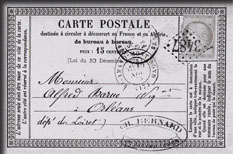
Official pre-paid French postcard, from
1873
- 1878 - 1902:
Undivided back period; postcard size 14 x 9 cm
1878:
Printed text - Coté réservé exclusivement
a l’adresse
1881: Printed text
- Ce Coté est exclusivement réservé a
l’adresse - 1891: First
tourist view cards produced in Marseille.
1896:
Printed text - République Francaise
1899:
Printed text - Carte postale - 1902:
It was permitted to place the stamp on the back or the front of
the postcard.
1904: Printed text - tous
les pays extrangeres n’acceptent pas la correspondence au
recto - 1907: divided
backs started to appear
- 1910:
generalised use of the divided back
After the First
World War, the popularity of postcards declined with competition
from photographic illustrations in newspapers and magazines, together
with the widespread use of cameras. Better communications of the
telephone, radio and more efficient petrol-fuelled transport also
played their part.
It was not until the 1970s that a combination
of fast, clean offset lithography printing and a concerted effort
by postcard publishers to make their cards interesting to buyers
- with multi-views, humorous pictures, novelty shapes - that the
French postcard trade was revived.
|
|
postage
stamp values to aid dating postcards
This section is a train-spotter’s delight of lists of dates and accompanying
postage rates. It is best used as a reference section, rather
than reading from beginning to end.
These postage rates can also be used to calculate a historic inflation.
Great Britain
1870 - 1918: ½d (one half-penny/one half-pence,
hap’ny)
apparently, postcard postage for overseas was 1d (one
penny)
1918, 3 June: 1d
1921, 13 January: 1½d
1922, 24 May: 1d
1940, 1 May: 2d (letter 2½d)
1957, 1 October: 2½d (letter
3d)
1965, 17 May: 3d (letter 4d)
1968,
16 September: postage tariffs changed to first and second class.
First-class post should arrive the next day, second-class post
taking longer.
First: 5d; second: 4d
After the conversion
to decimal currency (100 p = £1, instead of 240 d = £1):
1971, 15 February - first: 3p, second: 2½p
(6d)
1973, 10 September - first: 3½p,
second: 3p
1974 24 June - first: 4½p,
second: 3½p
1975, 17 March - first:
7p, second: 5½p
1975, 29 September
- first: 8½p, second: 6½p
1977,
13 June - first: 9p, second: 7p
1979, 20
August - first: 10p, second: 8p
1980, 24
February - first: 12p, second: 10p
1981,
26 January - first: 14p, second: 11½p
1982,
1 February - first: 15½p, second: 12½p
1983,
5 April - first: 16p, second: 12½p
1984,
3 September - first: 17p, second: 13p
1985,
4 November - first: 17p, second: 12p
1986,
20 October - first: 19p, second: 14p
1989,
2 October - first: 20p, second: 15p
1990,
17 November- first: 22p, second: 17p
1991,
16 September- first: 24p, second: 18p
1993,
11 November- first: 25p, second: 19p
1996,
8 July - first: 26p, second: 20p
1999,
27 April - first: 26p, second: 19p
2000,
27 April - first: 27p, second: 19p
2003,
8 May - first: 28p, second: 20p
2004, 1
April- first: 28p, second: 21p
2005, 17
April- first: 30p, second: 21p
...
2019 - first: 71p, second: 60p
Note: since 28 August 1989,
when non-specific price-point stamps were first issued, senders
more and more frequently use stamps denoted with 1st or with 2nd, rather than using stamps
with a specific price denomination. This will make dating more
difficult in the future.
United
States of America
U.S. stamp postage rates
are calculated by the ounce. A postcard, at a weight of 3 grams,
is well within the lowest postal rate, be it a half or a full
ounce. Thus, the postcard is given its own lower postal rate.
American
postcard tariffs:
1863, 3 March: 6¢
1873, 1 May: 1¢, with stamp pre-printed
on the cards
1883, 1 October: 4¢
1885, 1 July: 2¢
1898, 1 July: 1¢
1917, 2 November: 2¢
1919, 1 July: 1¢
1952,
1 January: 2¢
1958, 1 August: 3¢
1963, 7 January: 4¢
1968,
7 January: 5¢
1971, 8 May: 6¢
1974, 7 March: 8¢
1975,
14 September: 7¢
1975, 31 December:
9¢
1978, 29 May: 10¢
1981,
22 March: 12¢
1981, 1 November: 13¢
1985, 17 February: 14¢
1988,
3 April: 15¢
1991, 3 February: 19¢
1995, 1 January: 20¢
2001,
1 July: 21¢
2002, 30 June: 23¢
2006, 8 January: 24¢
...
2019 : 35¢
Letter postage rates
France
For further information on French definitives, visit Marianne
- a French national symbol, with French definitive stamps.
French postcard tariffs:
1872: 10 centimes - journeying in the same
town
 15
¢ - between two towns in France 15
¢ - between two towns in France
1875, 26 October: 15 c
 40
c - unfranked post card 40
c - unfranked post card
1878, 1 May: 10 c - France
 15
c - abroad 15
c - abroad
• Local post card rate ended
• The 15 centime rate lasted until 1917.
1917, 1 January: 15 centimes
 Post
card with less than 5 words: 10 c Post
card with less than 5 words: 10 c
1920, 1 April: 20 c
1926, 1 May: 30 c
1926, 9 August: 40 c
1937, 12 July: 55 c
1938, 17 November: 70 c
1939, 1 December: 80 c
1942, 5 January: 1 franc 20 centimes
/ 1.20 F
1945, 1 March: 1.50 F
1946, 1 January: 2.50 F
1947, 1 January: 4 F
1947, 3 January: 3.80 F
1947, 1 March: 3.50 F
1947, 8 July: 5 F
1948, 21 September: 8 F
1951, 8 December: 12 F
1957, 1 July: 15 F
1959, 6 January: 20 F
• The franc was devalued 100-fold so 1 new franc
= 100 old francs.
1960, 1 January: 20 centimes (the
1 January 1959 tariff expressed in new francs)
1965, 18 January: 25 c
1969, 13 January: 30 c
• From 1971, 4 January: there
are two tariffs - urgent and non-urgent. The urgent
postcard postage tariff followed the letter tariff.
The non-urgent postcards follow the rate for non-urgent
letters [un pli non-urgent]
1971, 4 January: 50 c (urgent), 30
c (non-urgent)
1974, 16 September: 80 c (urgent),
60 c (non-urgent)
1976, 2 August: 1F (urgent), 80 c (non-urgent)
1978, 15 May: 1.20 F (urgent), 1 F
(non-urgent)
1979, 15 October: 1.30 F (urgent),
1.10 F (non-urgent)
1980, 1 August: 1.40 F (urgent), 1.20
F (non-urgent)
1981, 1 September: 1.60 F (urgent),
1.40 F (non-urgent)
1982, 1 June: 1.80 F (urgent), 1.60
F (non-urgent)
1983, 1 June: 2 F (urgent), 1.60 F
(non-urgent)
1984, 1 July: 2.10 F (urgent), 1.70
F (non-urgent)
1985, 1 August: 2.20 F (urgent), 1.80
F (non-urgent)
1986, 1 August: 2.20 F (urgent), 1.90
F (non-urgent)
1987, 1 August: 2.20 F (urgent), 2
F (non-urgent)
1993, 5 July: 2.80 F (urgent), 2.40
F (simple)
1996, 18 March: 3 F (urgent), 2.70
F (economic)
• On 1 January 2002:
France’s currency changed to euro (symbol: €).
The exchange rate was 1€ to 6.55957F.
2003, 1 June:, 0.45
€ (economic),
2005, 1 March: 0.48 € (economic,
the same tariff as second-class letters - ecopli.)
2006, 1 October: 0.49 € (economic)
• From 1 March 2008, postcards
are included in the tariff for ecopli of less than 20g
2018, 1 March : 0.78€ (écopli)
2019, 1 March : 0.86€ (écopli)
From December
1917 to January 1947, there was a further tariff for
“non-personal correspondence” with a limit
of five hand-written words. The cards used were often
labelled Imprimé rather than Carte
Postale, and were usually printed advertising cards.
1909, 1 December: 5 centimes
1917, 1 January: 10 c
1920, 1 April: 15 c
1924, 25 March: 10 c
1925, 16 July: 15 c
1926, 1 May: 20 c
1926, 9 August: 25 c
1930, 21 April: 15 c
1932, 18 July: 20 c
1937, 12 July: 30 c
1938, 17 January: 40 c
1942, 5 January: 60 c
1945, 1 March: 1 franc
1946, 1 January: 1 franc 50 centimes
1947, 2 January: 2.80 F
1947, 1 March: 2.50 F
1947, 8 July: 3 F
1948, 21 September: 5 F
1949, 6 January: 8 F
1957, 1 July: 12 F
1959, 6 January: 15 F
1960, 1 January: 15 centimes (?) until
18 May 1964, when this tariff was ended.
|
|





















